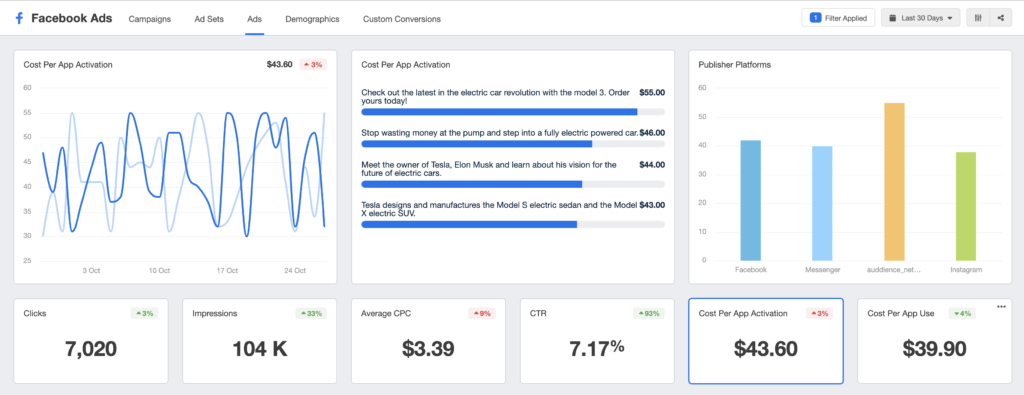In today’s digital age, advertising has become a critical component of any successful business’s marketing strategy. With the increasing importance of digital marketing, businesses need to have a deep understanding of their advertising performance to make data-driven decisions. Analytics plays a crucial role in monitoring and optimizing advertising performance.
Analytics is the practice of collecting, measuring, and analyzing data to gain insights into business performance. In the context of advertising, analytics involves monitoring and measuring key performance indicators (KPIs) such as click-through rates, conversion rates, and engagement rates. By analyzing these metrics, businesses can gain valuable insights into their advertising performance and make data-driven decisions to optimize their campaigns for maximum impact.
At our advertising agency, we understand the importance of analytics in monitoring and optimizing advertising performance and are pleased to provide you with the follow strategies:
Measuring Advertising Performance:
Analytics provides businesses with data to measure their advertising performance. It is an essential tool that can help businesses understand how well their advertising campaigns are performing. Metrics such as impressions, click-through rates, conversion rates, and cost per acquisition can be used to measure the effectiveness of advertising campaigns. By analyzing these metrics, businesses can identify areas of improvement and optimize their advertising strategies. For example, if a business is not receiving a significant number of clicks, they may need to adjust their targeting or ad messaging to make it more compelling and relevant to their audience. By measuring advertising performance, businesses can make data-driven decisions to improve their advertising strategies and drive better results.
Understanding the Audience:
Analytics provides businesses with valuable insights into their audience’s behavior. By tracking user engagement, businesses can understand which advertising strategies are working and which are not. Additionally, analytics can help identify the target audience’s demographics, interests, and behaviors, allowing businesses to optimize their targeting strategies. For example, if a business discovers that their audience is primarily composed of young adults, they may want to adjust their messaging and ad placements to better resonate with this group. By understanding their audience, businesses can create more relevant and effective advertising campaigns that drive better results.

Optimizing Ad Placement:
Analytics can help businesses optimize their ad placement strategies. By analyzing where ads are getting the most engagement, businesses can adjust ad placements for maximum impact. This includes adjusting ad placement by platform, ad format, and device type. For example, if a business discovers that their audience engages more with video ads on mobile devices, they may want to prioritize mobile video ad placements over other formats. By optimizing ad placement, businesses can ensure that their advertising campaigns are reaching their target audience in the most effective way possible.
Improving Ad Messaging:
Analytics can help businesses improve their ad messaging. By analyzing the messaging that resonates with the audience, businesses can adjust their ad copy, headlines, and calls-to-action for maximum effectiveness. This includes testing different messaging variations to see which is most effective in driving engagement and conversions. For example, if a business discovers that their audience responds well to ads with emotional messaging, they may want to adjust their messaging to be more emotive. By continually refining ad messaging based on analytics, businesses can create more compelling and effective advertising campaigns.

Adjusting Ad Spend:
Analytics can help businesses adjust their ad spend. By analyzing the cost per acquisition, businesses can adjust their budgets to ensure maximum return on investment. Additionally, analytics can help identify which advertising channels are most effective, allowing businesses to allocate their budgets accordingly. For example, if a business discovers that their social media advertising is driving more conversions than their search engine advertising, they may want to shift their budget to focus more on social media. By adjusting ad spend based on analytics, businesses can ensure that they are getting the most out of their advertising budgets and driving better results.

In conclusion, analytics plays a critical role in monitoring and optimizing advertising performance. By measuring advertising performance, understanding the audience, optimizing ad placement, improving ad messaging, and adjusting ad spend, businesses can make data-driven decisions to optimize their advertising strategies.
Key Points Summary:
- Analytics provides data to measure advertising performance
- Understanding the audience’s behavior helps businesses optimize their targeting strategies
- Ad placement can be optimized by analyzing engagement data
- Ad messaging can be improved by analyzing which messaging resonates with the audience
- Ad spend can be adjusted based on cost per acquisition and effectiveness of advertising channels
Contact us today to learn how we can help you leverage analytics to monitor and optimize your advertising performance.





